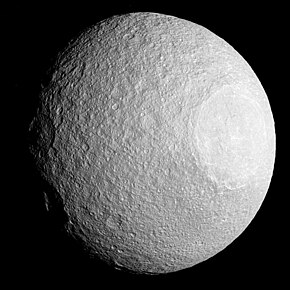
Back Tetis (maan) AF Tetis (satelite) AN تثيس Arabic Tefida (Saturnun peyki) AZ تتیس (قمر) AZB Тэфія (спадарожнік Сатурна) BE Тетида (спътник) Bulgarian Tetija (mjesec) BS Tetis (satèl·lit) Catalan Tethys (ôi-sĭng) CDO
 Tethys imaged by the Cassini orbiter, April 2015 | |
| Discovery | |
|---|---|
| Discovered by | G. D. Cassini |
| Discovery date | 11 March 1684 |
| Designations | |
Designation | Saturn III |
| Pronunciation | /ˈtɛθəs/[1] or /ˈtiːθəs/[2] |
Named after | Τηθύς Tēthys |
| Adjectives | Tethyan[3] /ˈtɛθiən, ˈtiː-/[1][2] |
| Orbital characteristics | |
| 294619 km | |
| Eccentricity | 0.0001[4] |
| 1.887802 d[5] | |
Average orbital speed | 11.35 km/s |
| Inclination | 1.12° (to Saturn's equator) |
| Satellite of | Saturn |
| Physical characteristics | |
| Dimensions | 1076.8 × 1057.4 × 1052.6 km[6] |
| 531.1±0.6 km[6][7] | |
| Mass | 6.1749×1020 kg[7] (1.03×10−4 Earths) |
Mean density | 0.9840±0.0033 g/cm3[7] |
| 0.146 m/s2 [a] | |
| 0.394 km/s[b] | |
| synchronous[8] | |
| zero | |
| Albedo | |
| Temperature | 86±1 K[12] |
| 10.2[13] | |
Tethys (/ˈtiːθɪs, ˈtɛθɪs/), or Saturn III, is the fifth-largest moon of Saturn, measuring about 1,060 km (660 mi) across. It was discovered by Giovanni Domenico Cassini in 1684, and is named after the titan Tethys of Greek mythology.
Tethys has a low density of 0.98 g/cm3, the lowest of all the major moons in the solar system, indicating that it is made of water ice with just a small fraction of rock. This was confirmed by the spectroscopy of its surface, which identified water ice as the dominant surface material. A further, smaller amount of an unidentified dark material is present as well. The surface of Tethys is very bright, the second-brightest of the moons of Saturn after Enceladus, and neutral in color.
Tethys is heavily cratered and cut by a number of large faults and trench-like graben. The largest impact crater, Odysseus, is about 400 km in diameter, whereas the largest graben, Ithaca Chasma, is about 100 km wide and more than 2,000 km long; the two surface features may be related. A small part of the surface is covered by smooth plains that may be cryovolcanic in origin. Like the other regular moons of Saturn, Tethys formed from the Saturnian sub-nebula—a disk of gas and dust that surrounded Saturn soon after its formation.
Tethys has been approached and observed by several space probes, including Pioneer 11 (1979), Voyager 1 (1980) and Voyager 2 (1981), with Cassini-Huygens observing the moon the most, and in greatest detail, during its extensive mission to the Saturnian system (2004-2017).
- ^ a b "Tethys". Oxford English Dictionary (Online ed.). Oxford University Press. (Subscription or participating institution membership required.)
- ^ a b "Tethys". Merriam-Webster.com Dictionary. Merriam-Webster.
- ^ JPL (2009) Cassini Equinox Mission: Tethys
- ^ Jacobson 2010 SAT339.
- ^ Cite error: The named reference
saturnian_sat_factwas invoked but never defined (see the help page). - ^ a b Roatsch Jaumann et al. 2009, p. 765, Tables 24.1–2.
- ^ a b c Jacobson, Robert. A. (1 November 2022). "The Orbits of the Main Saturnian Satellites, the Saturnian System Gravity Field, and the Orientation of Saturn's Pole*". The Astronomical Journal. 164 (5): 199. Bibcode:2022AJ....164..199J. doi:10.3847/1538-3881/ac90c9. S2CID 252992162.
- ^ Jaumann Clark et al. 2009, p. 659.
- ^ Verbiscer French et al. 2007.
- ^ Jaumann Clark et al. 2009, p. 662, Table 20.4.
- ^ Howett Spencer et al. 2010, p. 581, Table 7.
- ^ Stone & Miner 1982.
- ^ Observatorio ARVAL.
Cite error: There are <ref group=lower-alpha> tags or {{efn}} templates on this page, but the references will not show without a {{reflist|group=lower-alpha}} template or {{notelist}} template (see the help page).